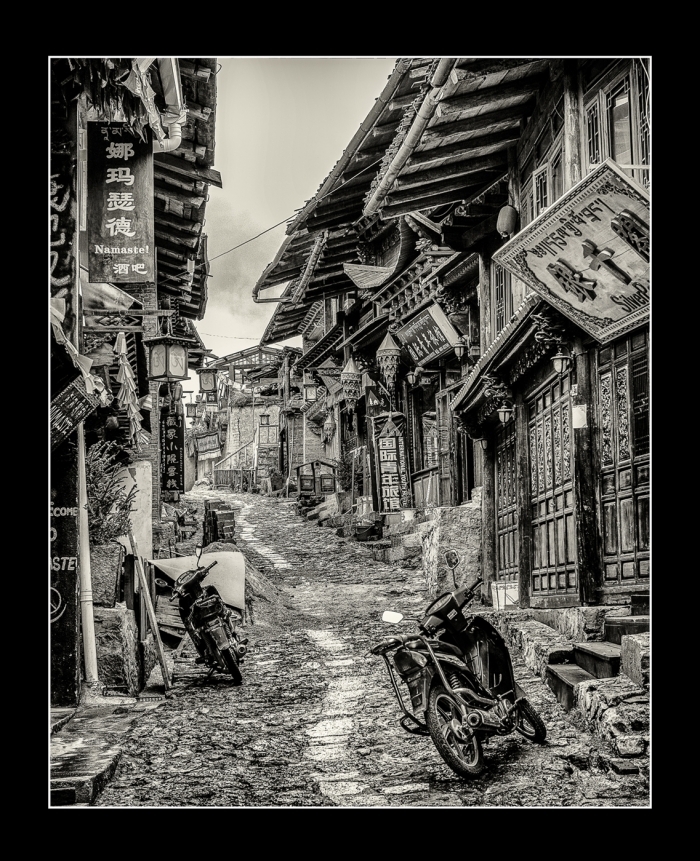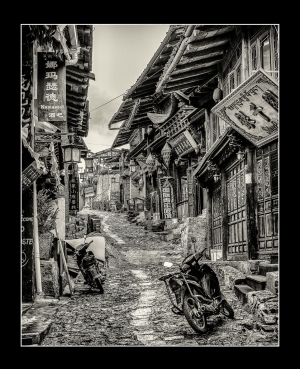Shangri-La - The Lost Heaven
Jean-Marc Heller
- Price: USD 1,200
- Art Type: Photography
- Size: 19 x 24
- English Comments: 0
- International Comments: 0
- Creating Date: 2014
- Introduction and Works of E-Moderne Gallerie >>
Work Overview
- The RAW picture was taken by a digital camera Nikon D800 with a 24-70mm zoom lens, focused at 70 mm at 500 ISO with aperture F: 9.0 and speed 1/50.
This image to my imagination is the path to the lost heaven. In James Hilton’s 1933 novel Lost Horizon, Shangri-La was described as a mystical, harmonious valley. In reality, it is an old village town sitting at 3,000m altitude in Yunnan Province of China, close to Tibet. The old town has many ancient wood buildings along the zigzagged stone ways. There are strong Tibetan influences of colors, architecture, and words. Those small stone roads would bring me to places of unknowns.
The ancient wood buildings and the presence of the modern bikes long the road created the feeling of “timeless.” The stone road and the sky between the roofs had the visual impact of “extension.” It’s exactly the Shangri-La that I wanted to see. A contrast of the past and yet it is not history, it is the presence.
Edition 1/10
Printed on a Matt Art Paper using EPSON DIGIGRAPHY Technology.
Artist signature, authenticity Certificate accompanies the artwork.
HELLER used LightRoom and Silver Fx add-on to get the monochrome effect, with the Sepia color giving the touch of timeless. I also used the sharpness cursor on overall picture to emphasize the wood structure.
Jean-Marc HELLER, an avocation photographer from Switzerland, spends many years working in China. He started interest in photography when he was fourteen years old. He used his late grandfather’s Rolleiflex and developed the films of black-and-white pictures in his parents’ bathroom. As he gradually changed his camera from film to digital, he has also developed his strengths and style.
In his spare time, he travels throughout the country documenting the real moments of day-to-day life of the ordinary people in the streets, through his lens in a true sense of documentary style. His images unfold the magnificence of what the nature offers and what the humans have created. His photos represent his understanding and appreciation of the culture, the people, and the countries he encountered. "The images told the wordless stories".
- Copyright Statement:
All the reproduction of any forms about this work unauthorized by Singing Palette including images, texts and so on will be deemed to be violating the Copyright Laws.
To cite this webpage, please link back here.
- >> English Comments
- >> Chinese Comments
- >> French Comments
- >> German Comments
- >>Report
- The alienation of the Albino
- Under the Sun
- Spring Bloom
- Peacock Garden
- Floating Sky garden
- Dreamland
- Blue Spring
- Blue Ray of the Sun
- One Day in 2004
- Zen Series #8
- Collage Treasures to Share
- Calligraphy
- Prayer Flags on the Himalayas
- Green Dot Gap
- Spotted Pigs
- Gap Folio
- Gap 123
- Gap 2
- Gap 1
- Poppies
- White Constellation
- White Constellation 2
- White Key Holes
- Connector
- Connector 2
- Connector 3
- Mirror 2
- Mirror
- Egg 2
- White Egg
- Verdant Constellation
- Untitled Abstract
- Transcendent echo series: Fantasia
- Treasure Hunter
- Erotic Landscape
- Essence of Evolution
- Dissimilar Faction #12
- Zen Series #11
- Zen Series #9, Zen Blue,
- Zen Series #27
- Zen Series #17
- Zen Series #19
- Zen Series #21
- Zen Series #7
- Transcendent Echo Series
- Transcendent Echo
- Urban Nocturne
- Face Beyond
- Zenith
- Under Growth #2
- Under Growth #1
- The Jungle Temple
- The Chinese Venice - Zhujiajiao
- Shangri-La - The Lost Heaven
- Harship of life
- Floating Flags in Blue Wind
- Material Diffused
- Circle Tree
- August Petroglyphs
- Imposed Symmetry
- Come Together
- On this side and beyond
- Last Chance
- Reflecting Stockholm
- The alienation of the Albino
- Migration in Flight
- Revolution Circa
- 9 Holes
- Sense of Space- Anxiety & Prayer
- One Hundred Signs of Demolitions
- Light
- Jumper
- Kung Fu
- Under the shadow of photosynthesis
- Landscape









 Singing Palette
Singing Palette